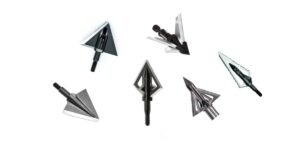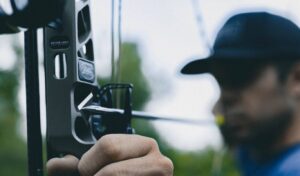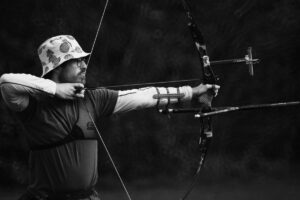Welcome to the world of bowhunting! If you’re new to this exciting sport, you’re probably eager to get started. One crucial skill you’ll need, which might not be immediately obvious, is how to safely carry your bow.
It’s not just about grabbing your bow and heading out – proper handling is key to preventing any injuries or damage to your gear.
In this beginner-friendly guide, we’ll walk you through some easy-to-follow methods for carrying your bow.
You’ll learn about the simple hand carry technique, the comfortable shoulder carry using a bow sling, the stylish across-the-back method, and the safe case carry for ultimate protection.
These tips are perfect for newcomers and will ensure you handle your bow like a pro from day one.
Contents (Jump to Topic)
ToggleLet’s dive in and get you ready for a safe and successful hunting season!
All such methods have their unique pros and cons, with the utilization of a mix of these tactics based on the situation at hand often being the best overall approach to carrying a bow.
Different Ways To Carry Your Bow
As previously mentioned there is a multitude of ways to carry your bow to and from your hunting destination. All of which serve particular needs and specific purposes.
An archer must also consider the differences between a compound and recurve bow, and what role these differences play when choosing how to carry a bow.
A recurve bow, as a general rule, is more rugged in design with less in the way of precision parts that can become damaged if unintentional contact with limbs and brush occurs in transit.
Compound bows feature sights with delicate pins, precision-adjusted rests, and perfectly machined cams, all of which must be adequately protected at all times.
These differences make the careful consideration of the following bow-carrying methods all the more important. So how do you carry a bow when not in use?
Carrying A Bow With Your Hand
Carrying your bow by hand is perhaps the simplest of all methods of bow transport. This method has many obvious pros, with one of the most significant being that your bow is always at the ready.
If you should encounter game while in route, you are ready to make the most of a shot opportunity in seconds. Another great advantage of carrying your bow by hand is that no additional equipment must be packed along during a hunt. This makes for a lightweight and efficient journey afield.
I personally prefer to carry my bow by hand. This is because I primarily hunt in farm country where I seldom park further than 1 mile away from where I am hunting.
This makes carrying by hand easily feasible. It also allows me have my bow at the ready as I ease to my stand for afternoon sits.
However, carrying your bow by hand comes with its share of cons as well. One such con is that this method can be quite impractical when a long hike is expected.
After miles of walking, your hands begin to cramp from extended periods of clinging to the grip. Carrying a bow by hand also becomes cumbersome if you have additional gear to pack, as you will only have one hand free to carry excess equipment with.
Pros-
- Simplistic
- No Extra Gear Is Needed
- Bow Is Always In Position For A Shot
Cons-
- Tiring And Cumbersome
- Leaves Bow Vulnerable To Damage
Carrying A Bow Using A Shoulder Sling
A shoulder sling can be used as a means of carrying a bow during distant treks while keeping both of your hands-free and available to pack other gear. This is also a relatively comfortable way of packing a bow, even during extensive travels.

click to find out more on AMAZON*
Because a bow is typically lightweight in design, little physical exertion is needed when carrying a bow with a shoulder sling. If you would like to see how to install a Bow Shoulder Sling, watch this video.
One definite con of using a shoulder sling is that you must always be aware of your surroundings. Because you have a precision piece of equipment dangling from your shoulder, absentmindedly squeezing between two trees can render hunt-ending damage to a bow sight if special care is not taken (recurve bow archer read.. the perfect recurve bow sight).
Also, carrying a bow with a sling means that you will have one additional piece of equipment to keep up with once you reach your destination.
Pros-
- Keeps Hands Free
- Not Physically Taxing
- Lightweight Alternative To Conventional Carry
Cons-
- Bow Is Not Always Ready For The Shot
- Bow Is Exposed To Potential Damage
How To Carry A Bow On Your Back
Carrying a bow on your back is best accomplished using a specialty sling. Several market offerings are available today for those that prefer this carry style.
The sling attaches to your bow and wraps over your shoulder and chest like a rifle sling. One great advantage of this method is that your hands are left free for other tasks while your bow is tucked away elsewhere.
This makes carrying your compound bow quite convenient, even during the lengthiest of hikes.
One con of carrying your bow on your back is that this method can take some time to become accustomed to. Until you have perfected sling tension and fitment, slipping of your sling and bow can be common.
It can also be somewhat difficult to keep your bow protected while carrying it on your back if hiking in inhospitable environments. Damage to bow components can easily occur if little thought is given to overhead limbs or other hazards.
Pros-
- Keeps Hands Free
- Is Convenient For Hiking Long Distances
- Is A Lightweight Method Of Carry
Cons-
- Takes Time To Get Used To
- Leaves Limbs And Other Components Exposed To Damage
Carrying A Bow In A Case
Carrying a bow in a case (read.. 5 recommended best bow cases) is the ultimate in protection for your archery equipment.
With your bow fully enclosed within its case’s confines, there is little possibility for component damage to take place.
As a side benefit, bow cases come with a built-in handle, allowing an archer to have a point of contact for handling.
One major drawback to carrying a bow in a case is that this method can add a significant amount of weight to your trek. Even soft-sided bow cases can be quite bulky in nature and cumbersome to contend with on long hikes.
You also have an additional piece of gear that you must contend with storing and concealing once you have reached your destination.
Pros-
- Completely Protects Bow From Damage
- Built-In Handle Allows For Ease Of Transport
Cons-
- Adds Extra Weight When Hiking Long Distances
- Is Bulky To Store And Conceal When Destination Is Reached
How To Carry A Bow On An ATV (Or Other Vehicle)
It is best carried in a case when carrying a bow on an ATV, or any vehicle for that matter. This helps to protect it against any impacts that are sustained while cruising through less-than-ideal conditions.
It is also wise to secure the bow case in place using bungee straps or binding of similar nature to prevent the case from shifting or a loss of equipment while traversing rough terrain. You could also consider using gun racks.
Why You Should NEVER Carry Your Bow By The String
Carrying your bow by its string is not advised under any circumstances. This is largely due to the potential for unwanted string stretch, as well as string wear from excess amounts of sweat and natural oils from your hands.
read.. how to papertune a bow
Although no one can say for certain if you will experience negative side effects to such carrying habits in your particular case, with your string being the heart of your bow, why take the unnecessary risk?
The Many Methods Of Carrying A Bow
- A bow sling keeps the bow readily accessible on your shoulder. Ensure the sling is securely attached above and below the grip using bow swivels or clips. Adjust the length so the bottom limb rests just above the ground at your side. Don’t overtighten at the top attachment or lengthwise to avoid twisting the limbs.
- Backpack bow holders with rubber-lined cradles provide padded protection when trekking longer distances. Stow the bow vertically with the string facing inwards towards your back rather than outwards. Carry additional arrow tubes or quivers separately to avoid stress on the tips.
- For short hauls, the bow grip handhold secures the bow for transport at your side. Face outward the cables, string, and cams to keep them obstacle-free. Use your other hand to manage gear shifts or balance as needed. Don’t grasp the limbs which risks alignment damage. Employ handhold caution in dense brush or muddy conditions.
Feel free to leave any comments that you might have, as we enjoy receiving feedback from our readers.







Conversation | 1 comment:
Shadiversity on YouTube has a seemingly new way to carry a bow while hunting or on the range with his nail catch. It does work out well on the range with my back quiver as well.